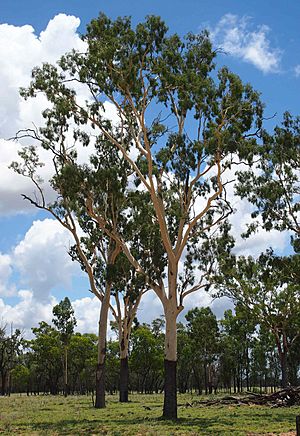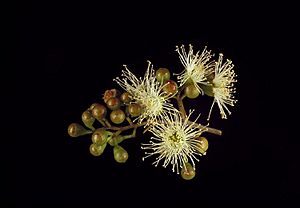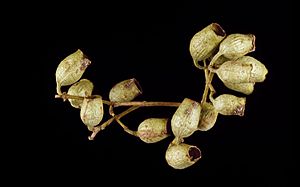Carbeen facts for kids
Quick facts for kids Carbeen |
|
|---|---|
 |
|
| Scientific classification | |
| Genus: |
Corymbia
|
| Species: |
tessellaris
|
| Synonyms | |
The Corymbia tessellaris, often called carbeen or Moreton Bay ash, is a special tree. It is found only in north-eastern Australia. This tree has unique bark that is rough and blocky at the bottom. Higher up, the bark becomes smooth and whitish. Its leaves are long and thin, shaped like a spear. The Carbeen grows white flowers in groups of three or seven. These flowers later turn into cool, urn-shaped fruits.
Contents
What the Carbeen Tree Looks Like
The Carbeen tree usually grows very tall. It can reach heights of 30 to 35 meters. That's as tall as a 10-story building! Its trunk is almost always straight. It makes up a big part of the tree's height. The top of the tree has a crown of thin branches.
The bark on the lower part of the trunk is rough and greyish. It looks like small squares or tiles. This rough bark can go up to 1 to 4 meters high. Above that, the bark suddenly changes to smooth and whitish.
Young Carbeen plants have lance-shaped leaves. They are about 55 to 110 millimeters long. These leaves are arranged in pairs. Adult leaves are longer and thinner. They are about 90 to 240 millimeters long. They are the same green or greyish color on both sides.
The tree's flower buds grow at the ends of its branches. They are found in groups of three or seven. These buds are oval or pear-shaped. They are about 4 to 6 millimeters long. The flowers are white and usually bloom between October and January. After flowering, the tree produces cylindrical or urn-shaped fruits. These fruits are thin-walled capsules. They are about 6 to 12 millimeters long.
How the Carbeen Got Its Name
The Carbeen tree was first officially described in 1859. A scientist named Ferdinand von Mueller gave it the name Eucalyptus tessellaris. Later, in 1995, two other scientists, Ken Hill and Lawrie Johnson, changed its name. They renamed it Corymbia tessellaris. This new name is what we use today.
Where the Carbeen Tree Grows
The Corymbia tessellaris is found all over north-eastern Australia. It grows in open forests and woodlands. You can find it from the Cape York Peninsula down through eastern Queensland. It also grows near Narrabri and Kyogle in northern New South Wales. Some Carbeen trees are also found on islands in the Torres Strait and in southern New Guinea.
How People Use the Carbeen Tree
Traditional Uses
The Yirrganydji and Djabugay people are Indigenous groups in Australia. They have used the Carbeen tree for a long time. They make medicine from the tree to help heal wounds. They also use it to treat conditions like dysentery. The wood from the Carbeen tree is strong. They use it to make tools for daily life.
Gardening Uses
The Carbeen tree is a tough plant. It can handle strong winds, hot weather, and dry conditions. This makes it a good choice for planting in gardens. New Carbeen trees can be grown from their seeds.
Industrial Uses
The wood of the Carbeen tree is very heavy. Because it is so strong, it has been used to build bridges. It was also used to make spears in the past. The tree also produces many natural compounds. These compounds, like pinenes and limonene, can be useful for different industries.
See also
 In Spanish: Corymbia tessellaris para niños
In Spanish: Corymbia tessellaris para niños



